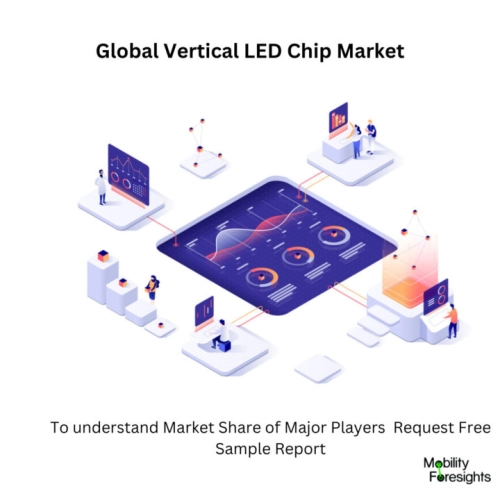
- Get in Touch with Us

Last Updated: Apr 25, 2025 | Study Period: 2024-2030
Compared to lateral LED, the vertical LED (VLED) is superior for high power applications. Higher power, efficiency, reduced current congestion, better light extraction, and better heat sinking are just a few of the advantages of VLED.
Using a high electrical and heat conductive substance, the vertical LED method Bonds the second substrate. Also capable of removing the substrate, forming the electrode, and chip shaping
The primary vertical LED technologies include substrate removal, bonding a second conductive substrate, the deposition of reflecting metal, and surface treatment to enhance light extraction.
The primary uses are for outdoor and indoor lighting, flash, auto headlights, and traffic signals.

The Global Vertical LED chip market accounted for $XX Billion in 2023 and is anticipated to reach $XX Billion by 2030, registering a CAGR of XX% from 2024 to 2030.
The new Luxeon 5050 mid-power packaged LED has been added to Lumileds' range for outdoor SSL and high-output industrial SSL solutions.
The Lumileds LED produces 350 lm at 2W and has an efficiency of 175 lm/W. That performance is for a 4000K-CCT LED operating at 85°C with a 70 CRI.
Although Lumileds will provide products with CCT as low as 2700K and CRI as high as 90, the lighting utilised in the target applications typically has a cool CCT and moderate colour performance.
In the flip-chip architecture, the electrodes are on the bottom surface for a simpler and more reliable connection to the package substrate, while the surface next to the growth substrate becomes the light-emitting surface.
| Sl no | Topic |
| 1 | Market Segmentation |
| 2 | Scope of the report |
| 3 | Abbreviations |
| 4 | Research Methodology |
| 5 | Executive Summary |
| 6 | Introduction |
| 7 | Insights from Industry stakeholders |
| 8 | Cost breakdown of Product by sub-components and average profit margin |
| 9 | Disruptive innovation in the Industry |
| 10 | Technology trends in the Industry |
| 11 | Consumer trends in the industry |
| 12 | Recent Production Milestones |
| 13 | Component Manufacturing in US, EU and China |
| 14 | COVID-19 impact on overall market |
| 15 | COVID-19 impact on Production of components |
| 16 | COVID-19 impact on Point of sale |
| 17 | Market Segmentation, Dynamics and Forecast by Geography, 2024-2030 |
| 18 | Market Segmentation, Dynamics and Forecast by Product Type, 2024-2030 |
| 19 | Market Segmentation, Dynamics and Forecast by Application, 2024-2030 |
| 20 | Market Segmentation, Dynamics and Forecast by End use, 2024-2030 |
| 21 | Product installation rate by OEM, 2023 |
| 22 | Incline/Decline in Average B-2-B selling price in past 5 years |
| 23 | Competition from substitute products |
| 24 | Gross margin and average profitability of suppliers |
| 25 | New product development in past 12 months |
| 26 | M&A in past 12 months |
| 27 | Growth strategy of leading players |
| 28 | Market share of vendors, 2023 |
| 29 | Company Profiles |
| 30 | Unmet needs and opportunity for new suppliers |
| 31 | Conclusion |
| 32 | Appendix |